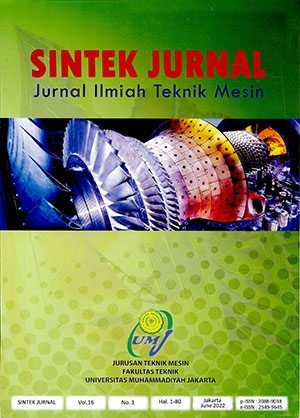Peningkatan konduktivitas termal oli sintetis sebagai fluida pemindah panas melalui pencampuran serbuk besi
Main Article Content
Abstract
Article Details
- Articles published in SINTEK JURNAL are licensed under a Creative Commons Attribution-ShareAlike 4.0 International license. You are free to copy, transform, or redistribute articles for any lawful purpose in any medium, provided you give appropriate credit to the original author(s) and SINTEK JURNAL, link to the license, indicate if changes were made, and redistribute any derivative work under the same license.
- Copyright on articles is retained by the respective author(s), without restrictions. A non-exclusive license is granted to SINTEK JURNAL to publish the article and identify itself as its original publisher, along with the commercial right to include the article in a hardcopy issue for sale to libraries and individuals.
- By publishing in SINTEK JURNAL, authors grant any third party the right to use their article to the extent provided by the Creative Commons Attribution-ShareAlike 4.0 International license.
References
P. Wang, R. Liang, Y. Yu, J. Zhang, J. Lv, M. Bai, The flow and heat transfer characteristics of engine oil inside the piston cooling gallery, Appl. Therm. Eng. 115 (2017) 620–629. https://doi.org/10.1016/j.applthermaleng.2017.01.014.
M. Ma, Y. Zhai, P. Yao, Y. Li, H. Wang, Synergistic mechanism of thermal conductivity enhancement and economic analysis of hybrid nanofluids, Powder Technol. 373 (2020) 702–715. https://doi.org/10.1016/j.powtec.2020.07.020.
K. Vignarooban, X. Xu, A. Arvay, K. Hsu, A.M. Kannan, Heat transfer fluids for concentrating solar power systems - A review, Appl. Energy. 146 (2015) 383–396. https://doi.org/10.1016/j.apenergy.2015.01.125.
L.A. Weinstein, J. Loomis, B. Bhatia, D.M. Bierman, E.N. Wang, G. Chen, Concentrating Solar Power, Chem. Rev. 115 (2015) 12797–12838. https://doi.org/10.1021/acs.chemrev.5b00397.
R. Ling-zhi, Z. Xin-gang, Z. Yu-zhuo, L. Yan-bin, The economic performance of concentrated solar power industry in China, J. Clean. Prod. 205 (2018) 799–813. https://doi.org/10.1016/j.jclepro.2018.09.110.
M.S. Praveen Kumar V, Analysis of Heat Transfer Fluids in Concentrated Solar Power (CSP) A Review Paper, Int. J. Eng. Res. Technol. 3 (2014) 239–241. www.ijert.org.
L. Heller, Literature review on heat transfer fluids and thermal energy storage systems in CSP plants, Lit. Rev. Heat Transf. Fluids Therm. Energy Storage Syst. CSP Plants. (2013). http://sterg.sun.ac.za/wp-content/uploads/2011/08/HTF_TESmed_Review_2013_05_311.pdf.
I. Sarbu, C. Sebarchievici, A comprehensive review of thermal energy storage, Sustain. 10 (2018). https://doi.org/10.3390/su10010191.
T. Sokhansefat, A.B. Kasaeian, F. Kowsary, Heat transfer enhancement in parabolic trough collector tube using Al 2O3/synthetic oil nanofluid, Renew. Sustain. Energy Rev. 33 (2014) 636–644. https://doi.org/10.1016/j.rser.2014.02.028.
G.J. Rani, G.S. Rani, A. Praveen, Materials Today : Proceedings Nano fluids effect on crossflow heat exchanger characteristics – Review, Mater. Today Proc. (2020). https://doi.org/10.1016/j.matpr.2020.10.210.
Z. Xuan, Y. Zhai, M. Ma, Y. Li, H. Wang, Thermo-economic performance and sensitivity analysis of ternary hybrid nanofluids, J. Mol. Liq. (2020) 114889. https://doi.org/10.1016/j.molliq.2020.114889.
Z. Chen, D. Zheng, J. Wang, L. Chen, B. Sundén, Experimental investigation on heat transfer characteristics of various nanofluids in an indoor electric heater, Renew. Energy. 147 (2020) 1011–1018. https://doi.org/10.1016/j.renene.2019.09.036.
C.V.C. Vishal, R.K. Kanala, C.S.K. Raju, P.K. Madathil, P. Saha, B.R. Rao, G. Sriganesh, K. Ramesh, Sub-micron sized metal oxides based organic thermic fluids with enhanced thermo-physical properties, Appl. Therm. Eng. 163 (2019) 114337. https://doi.org/10.1016/j.applthermaleng.2019.114337.
Y.J. Chiu, W.M. Yan, H.C. Chiu, J.H. Jang, G.Y. Ling, Investigation on the thermophysical properties and transient heat transfer characteristics of composite phase change materials, Int. Commun. Heat Mass Transf. 98 (2018) 223–231. https://doi.org/10.1016/j.icheatmasstransfer.2018.09.011.
C.M. Mason, R.M. Doe, The determination of the thermal conductivity of fluids, J. Chem. Educ. 5 (2006) 182–184. https://doi.org/10.1021/ed014p182.
U. States, A. Engineers, T. Sae, Engine oil viscosity classification, Tribol. Int. 10 (2002) 77–80. https://doi.org/10.1016/0301-679x(77)90102-5.
A. Shabib-Asl, M.A. Ayoub, I.M. Saaid, P.P.J. Valentim, Experimental investigation into effects of crude oil acid and base number on wettability alteration by using different low salinity water in sandstone rock, J. Japan Pet. Inst. 58 (2015) 228–236. https://doi.org/10.1627/jpi.58.228.
D.C. Adhitya, Penambahan Pasir Vulkanik untuk Meningkatkan Sifat Termal Composite PCM sebagai Thermal Energy Storage, 2020.


